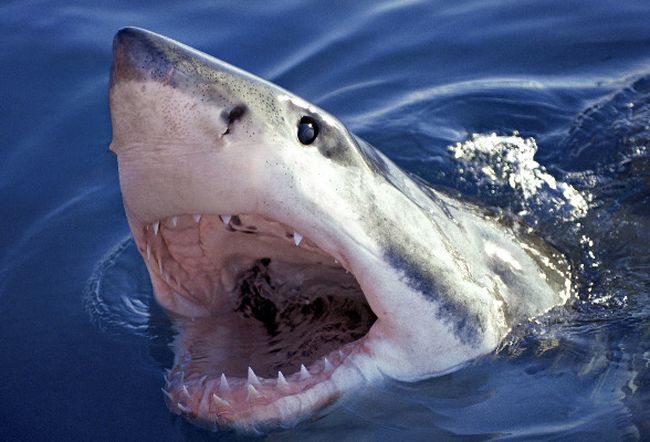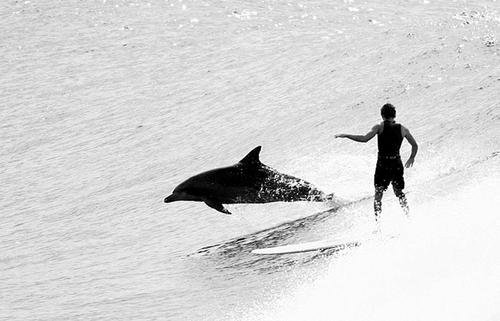But, I don't think I would go paddling with a shark off to my side. I'm just saying.
Marine Life Monday. "Golf Course Hazard!"
Not just a hazard to your score, but to your life. Mommy!
A half dozen Bull sharks got stranded in a small lake after a flood near Brisbane, Australia. It's said that they are fond of golf balls, birds and small mammals. The sharks are often seen trying to tempt the golf club members into the water, something about the joy of swimming.
The Bull shark, Carcharhinus leucas, also known as Zambezi shark or unofficially known as Zambi in Africa and Nicaragua shark in Nicaragua, is a shark common worldwide in warm, shallow waters along coasts and in rivers. The bull shark is well known for its unpredictable, often aggressive behavior.
The Bull shark is most famous for its remarkable ability to thrive in both saltwater and freshwater and can travel far up rivers. They have even been known to travel as far up as Indiana in the Ohio River and Illinois in the Mississippi River, although there have been few recorded attacks. As a result, they are probably responsible for the majority of near-shore shark attacks, including many attacks attributed to other species.
Links: Wikipedia | Courier Mail | Ichthyology at the Florida Museum of Natural History
Fish On Fridays.
You never know what lurks beneath the seas.
Hello Joe.
What do you know?
Do you mind sir, I'm trying to swim.
Picture: Austral International
This photo was attached to an article on news.com.au titled, "Sperm whale poo helps planet." Lovely!
Marine Life Monday.
Wonderful underwater images of sea life at the Cortes Bank.
Fish On Fridays. Big Fish!
The Best Body Surfers In The World.
Monday Morning Mermaid. Holly Beck!
Look guys, a carry over from Friday....a Big Fish!
Happy Monday. Now get back to work.
Cue The Music!
Big Fish, Shallow Water.
Yikes boys and girls, sharks come close to shore.
Speaking of sharks, read about Shawn's close encounter with a beasty 2 miles off the coast of the Big Island.
Fish On Fridays.
Body Surfing Photo Of The Day.
Jellys.
[vimeo http://www.vimeo.com/23079092 w=465&h=262]
JELLYFISH LAKE, PALAU from Sarosh Jacob on Vimeo.
A little information on Jellyfish Lake…
Jellyfish Lake is located on Eli Malk Island in the Republic of Palau. Twelve thousand years ago these jellyfish became trapped in a natural basin on the island when the ocean receded. With no predators amongst them for thousands of years, they evolved into a new species that lost most of their stinging ability as they no longer had to protect themselves. They are pretty much harmless to humans although some people with very sensitive skin may get a minor sting from them. If you are allergic to jellyfish you should wear a wetsuit or protective clothing.
These fascinating creatures survive by sharing a symbiotic relationship with algae that live inside of them. At night, the jellyfish go down to the depths of the lake where the algae feed on nutrients. During the day, the jellyfish come back to the surface and follow the sun across the lake in a massive migration. The algae convert the energy of the sun via photosynthesis into a sugar that feeds the jellyfish.
It is not possible to scuba dive in this lake because the nutrient rich layer at around 50 feet and below contains hydrogen sulphide which is highly toxic to humans. If a scuba diver was to swim in that layer, the toxins would enter the body through the skin and that exposure could be fatal. Snorkeling however, is perfectly safe and if you ever find yourself in Palau one day, you should make your way to this special place. The experience of swimming through millions of jellyfish is quite surreal and Palau is the only place in the world where you can do just that!
I hope you enjoy the video and thank you for watching. - Sarosh Jacob.
Film / Edit: Sarosh Jacob
Equipment: Canon 5D Mark II, Simga 15mm Fisheye Lens and Aquatica Housing
Music: Radiohead "Nude"

Eh Brah, Fins Only!
Hey, Did You Forget Today Is Friday?

Some guys are waiting for a wahine. Cough her up!
I know, one of you guys wants a blogroll. Click the word "Links," I'm pretty sure that will get you to where you want to go. The rest of you could give a rats "behind" about that, on to a wahine you say. She will be here in two shakes, so hold your horses.

Marine Life Monday. Counting Sharks.
In the first census of its kind, research led by UC Davis and Stanford University found that there are far fewer white sharks off central California than biologists had thought.
The study, published in the journal Biology Letters, is the first rigorous scientific estimate of white shark numbers in the northeast Pacific Ocean. It is also the best estimate among the world's three known white-shark populations (the others are in Australia/New Zealand and South Africa).
The researchers went out into the Pacific Ocean in small boats to places where white sharks congregate. They lured the sharks into photo range using a seal-shaped decoy on a fishing line. From 321 photographs of the uniquely jagged edges of white sharks' dorsal fins, they identified 131 individual sharks.
From these data they used statistical methods to estimate that there are 219 adult and sub-adult white sharks in the region. (White sharks are classed as sub-adults when they reach about 8-9 feet in length and their dietary focus shifts from eating fish to mostly marine mammals. They are adults when they reach sexual maturity -- for males, that is about 13 feet long; for females, it is about 15 feet.)
"This low number was a real surprise," said UC Davis doctoral student Taylor Chapple, the study's lead author. "It's lower than we expected, and also substantially smaller than populations of other large marine predators, such as killer whales and polar bears. However, this estimate only represents a single point in time; further research will tell us if this number represents a healthy, viable population, or one critically in danger of collapse, or something in-between."
"We've found that these white sharks return to the same regions of the coast year after year," said study co-author Barbara Block, a Stanford University marine biologist and a leading expert on sharks, tunas and billfishes. "It is this fact that makes it possible to estimate their numbers. Our goal is to keep track of our ocean predators."
Satellite tagging studies have demonstrated that white sharks in the northeast Pacific make annual migrations from coastal areas in Central California and Guadalupe Island, Mexico, out to the Hawaiian Islands or to the "White Shark Café," a region of the open ocean between the Baja Peninsula and Hawaii where white sharks have been found to congregate -- and then they return to the coastal areas.
Text and Video by University of California - Davis

Fish On Fridays.

A wahine, surfboard, and fish. Does life get any better than this?

Surfing Photo Of The Day.

Body surfing versus stick surfing.

A Guy, His Horse, And Dolphins!
I couldn't resist posting this video. Another one from Conjuminando.
And Now For Something Completely Different.
Synchronized fish or fun with magnets?
Fu Yandong, a Chinese magician has sparked outrage from animal rights groups with a trick in which he gets goldfish to swim in sync. They suspect that Fu uses magnets embedded inside the fish.
The trick involves six fish in a shallow tank on a covered table, who swim in formation at Fu's command.
Fu has so far refused to reveal the secret.
"My fish," he wrote on his microblog, are "living happily".
But his assurances have failed to quell the controversy.
In an open letter on Monday, 53 Chinese non-governmental organisations urged TV stations not to broadcast Fu's act in the future, and demanded the trick not be repeated during CCTV's Lantern Festival special.
The groups expressed fears the trick could lead to animals being tortured if viewers tried to copy it.



